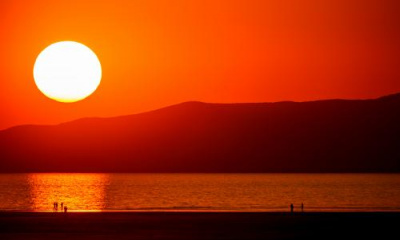SALT LAKE CITY — Utah Gov. Spencer Cox signed a new executive order Friday, calling on the Utah Division of Forestry, Fire and State Lands to raise the Great Salt Lake causeway berm by 5 feet, in an effort to improve salinity conditions that are "threatening the Great Salt Lake ecosystem."
The order specifically calls on the division to raise the berm, which is located by a 180-foot breach in the causeway — from 4,187 feet to 4,192 feet — in an effort to stop the growing salinity levels in the southern arm of the lake. The division had already raised the berm by 4 feet last year because of this issue.
"The Great Salt Lake is crucial to our environment, ecology and economy and we must do everything we can to protect it," Cox said in a statement Friday. "We've been blessed with significant snowpack so far this winter, and this executive order will allow the state to move quickly to increase the lake level in the south arm by capturing spring runoff. We don't want to miss this opportunity to safeguard the lake."
The order also calls on the Utah Department of Natural Resources and the Utah Department of Environmental Quality to prepare a berm management plan to guide future adjustments to berm height. The order is set to expire once the plan is adopted and implemented.
Kim Wells, a spokeswoman for the Utah Department of Natural Resources, explained that it's a "pretty easy process" to raise the berm, which she said is expected to happen within the next week. She added that the timing of Friday's order comes at an important time in the Great Salt Lake ecosystem.
Brine shrimp cysts begin to hatch in the spring, playing a vital role in the ecosystem. They are considered a "valuable food source" for the 10 million migratory birds that travel through the lake every year, according to the Utah Division of Wildlife Resources. The division also notes that brine shrimp are also valuable to the economy when they are harvested at the end of every year.
But brine shrimp need to have the perfect conditions to thrive.
"Balancing out that salinity is critical right now," Wells said. "So that's exactly what we're trying to — just capture everything we can to balance that salinity and make sure that we're protecting the ecosystem."
Raising the berm near the causeway is one of the early solutions to a growing problem with the drying lake. The Great Salt Lake reached a new all-time low lake level last year, and experts said that the southern arm has gotten saltier as the lake shrinks.
The southern arm is typically less salty because water from the Jordan, Bear, Ogden and Weber rivers flow into it. One possible reason for the change is that the northern arm's water is heavier and is pushing higher concentrations of salt into the southern arm, division officials said last year.
Crews raised the berm in an effort to stop the northern arm's impact, and restore the normal balance of salinity between the two arms. That's what is happening again less than a year later.
Wells said it's unclear how long it will take to see any benefits from the emergency measure. However, they will raise the berm ahead of this year's spring runoff, which is anticipated to be much better than last year's or the year before because of a stronger snowpack on top of wetter soil moisture.
"We're just trying to capture those freshwater inflows coming in and we're trying to maximize the benefits of the spring runoff in the south arm," she said. "We've had a great snowpack this year, we're reaping the benefits of water, and if we leave the berm at the elevation it is now, we're losing that water to the north arm and we're not able to capture the benefits of that spring runoff."
Contributing: Matt Hugie

.jpeg)







